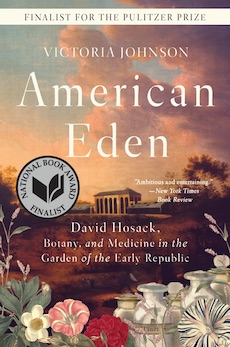By David Madden
An assistant professor of urban policy and planning and teacher of New York City history at Hunter College, Victoria Johnson has embraced the intriguing task of reviving interest in the once internationally famous American botanist David Hosack, telling a story that simultaneously offers facets of the history of the young nation.
Educated in Europe, Hosack was a visionary who put to work daily, tirelessly an enormous practical ability, resulting in 46 years of dedicated work. He “had a sturdy toolbox of a heart”; to Hosack, “all failures and setbacks” were “opportunities for self-improvement and renewed optimism.”
Hosack was born in 1769 in British-occupied New York City during the American Revolution and died in 1835. Imposing, tall, and attractive, Hosack married four times and had three children, one of whom worked with him creating Elgin, America’s first botanical garden.
He was a complex person who stayed clear of politics but not of politicians, getting help from them to finance his arboretum. He took no position on slavery. A Columbia College professor of botany, he was a mesmerizing lecturer, revered and loved as a very exacting teacher of young physicians. Hosack became nationally famous for his innovative surgical procedures, entering into “the slippery inner world of the human body.”
Hosack developed and pursued a unique vision of a grand arboretum. Much of his time was expended exhorting, pleading, begging, repeatedly, in New York among the wealthy, in the legislature at Albany, and at Columbia, which bought Elgin when all Hosack’s efforts failed to secure long-term funding for his celebrated, then ill-treated, finally ill-fated arboretum. He tried in vain to get Elgin back. When the city owned it, he saw Elgin mismanaged, neglected, plants sold or stolen, and finally in ruins. Then Elgin, “the garden of his dreams,” became Bloomingdale Insane Asylum. In retirement, he bought Hyde Park Estate, hundreds of acres on the Hudson, compared with Elgin’s five, and enjoyed it immensely for eight years.
Hosack sought plants that not only inspired an appreciation of floral beauty but that possessed healing powers. He advocated turning gardens into natural classrooms for teaching the use of plants to treat or cure. Often seen hunting plants along the Hudson, he shared seeds and plants with many like-minded men. Throughout most of his life, Hosack learned in person or through protracted correspondence about plants and horticulture from the foremost practitioners of new ideas, especially from the mentor of his years in England, William Curtis, proponent of the Linnaeus system. Johnson offers vivid portraits of some of Hosack’s many famous friends and acquaintances—American, French, and British—among them Benjamin Rush, DeWitt Clinton, Alexander von Humboldt, François André Michaux, and the painter and museum creator Charles Willson Peale. Most were involved in various ways in “the international effort to catalogue the flora of the whole planet.” President Thomas Jefferson ordered Lewis and Clark to bring back from their great expedition seeds, plants, drawings, and notes, and Hosack impatiently requested access to them.
Ironically, he saved the life of the young son of his very good friend and close neighbor Alexander Hamilton and was Hamilton’s choice to be attending physician at the scene of the internationally famous duel in which another good friend, Aaron Burr, killed Hamilton. At only 19, another of Hamilton’s sons, Philip, was killed in a duel. Another irony was that Hosack cared for Theodosia Burr, Aaron’s daughter, as he had cared for Hamilton’s son.
Johnson’s style is startling, witty, and lucid. Hosack attended to victims of the frequent epidemics of yellow fever and other diseases. “Exposed coffins stuck out like rows of rotten teeth.” A “procession flowed like a dark glacier.” He loved books: “They suffused the quiet world around him with layers of meaning.” Hosack envisioned “the kind of garden that was already pushing up its first pale shoots in his mind.” Each step “unfolded before him with perfect clarity.” To Hosack, each species of plant at Elgin was “yet another entry in the living encyclopedia that his men were inscribing with their spades and rakes on the face of Manhattan.” At a commemoration, Hosack sat at the head table beneath an arbor made of flowers, “looking like the president of the republic of botany.”
David Hosack “had done more than any man of his generation to foster in his fellow Americans a fascination with plants.” “Over and over, in the face of criticism and misfortune,” Johnson writes, “he rallied people around him to create the charitable, medical, and cultural institutions that make cities inhabitable and that educate a nation for generations to come.”
“Botany illiteracy” once blighted the American landscape. But today more than 400 botanical gardens grace the nation. Having read this extraordinarily well-researched and well-written biography, Johnson’s readers may stand at the heart of Manhattan in front of Radio City Music Hall in Rockefeller Center and imagine Hosack’s Elgin Botanical Garden buried beneath.
I wanted to read the final chapter of this brilliant, inspiring story sitting in my own lush garden in the mountains of western North Carolina. So I did.
David Madden (ΦBK, University of Tennessee, 1979) is the author of books in many genres. His biography of James M. Cain, tough-guy novelist of the thirties, is forthcoming.




